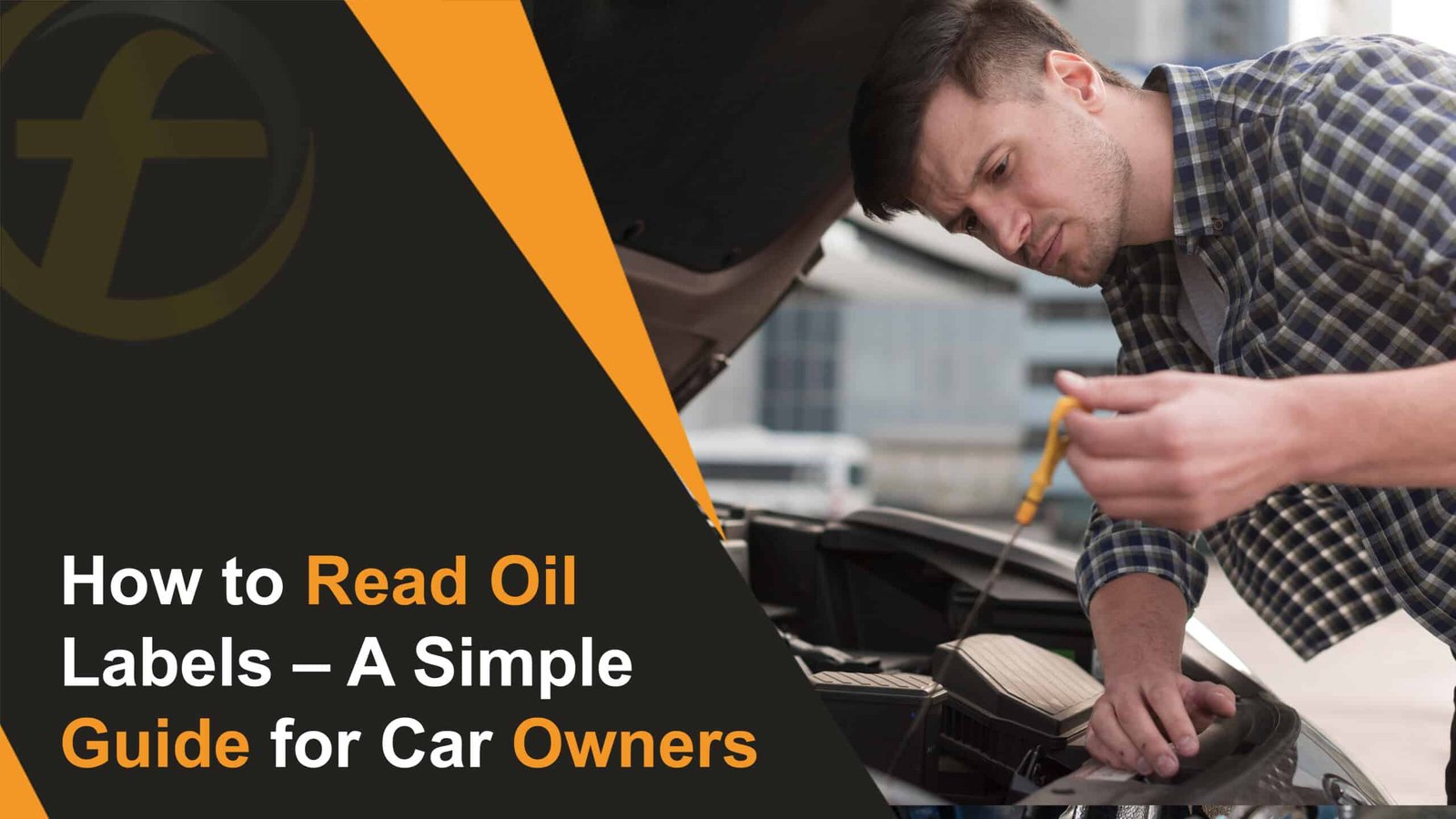
Choosing the right engine oil can be confusing with all the numbers, letters, and labels on the bottle. But understanding what these labels mean is important for keeping your car running smoothly. Engine oil protects your engine, reduces wear, and keeps everything moving properly.
In this guide, we’ll explain engine oil grades, types of oils, viscosity numbers, and labels, plus tips to help you pick the best oil for your car. By the end, you’ll know how to read oil labels like a pro and make sure your engine stays healthy and strong.
What Are Engine Oil Grades?
Engine oils are given grades to show how thick or thin they are. This is called viscosity, which means how easily the oil flows. Thick oil flows slowly, and thin oil flows faster. Oils act differently when it’s cold or hot. Usually, a lower number means the oil is thinner and flows more easily.
The Society of Automotive Engineers (SAE) made a system to grade engine oils. There are 14 classes:
- Winter classes (for cold weather) have a number and the letter W: 0W, 5W, 10W, 15W, 20W, 25W.
- Summer classes (for hot weather) are the numbers after the W: W-8, W-12, W-16, W-20, W-30, W-40, W-50, W-60.
The two numbers tell you:
- First number (before W): How the oil flows when it’s cold, like when you start your engine.
- Second number (after W): How the oil flows when the engine is hot and running normally.
Both numbers tell us how thick or thin the engine oil is:
- The first number (before the W): Shows how the oil flows when it’s cold, like when you first start your engine.
- The second number (after the W): Shows how the oil flows when the engine is hot and running normally.
What Does 5W-30 Mean?
Let’s break it down using 5W-30 as an example:
- 5W shows how the oil flows when it’s cold. A smaller number means the oil flows faster at engine start-up.
- 30 shows how the oil flows when the engine is hot and running normally.
Engine oil gets thicker when it’s cold and thinner when it’s hot. So:
- A 5W-30 flows faster than a 10W-30 when the engine is cold.
- A 10W-30 flows faster than a 10W-40 when the engine is hot.
Thin oil (low viscosity) protects your engine better in cold weather. Thick oil (high viscosity) keeps a strong layer of lubrication, reducing friction and wear, and protects your engine when it’s hot.
What Are the Common Types of Motor Oil?
First, don’t get confused by the terms motor oil and engine oil. They mean the same thing, so you don’t need to worry about choosing between them.
Conventional Oil
This is the oldest type of motor oil. It comes from crude oil and is refined with added chemicals to make it work better in your engine. Conventional oil is usually the cheapest, but it needs to be changed more often. So you save money at first, but replace it more frequently.
Synthetic Oil
Synthetic oil is made in a lab using special chemicals. It helps the engine run smoothly at very hot or very cold temperatures and lasts much longer than conventional oil. Usually, you change it every 10,000–20,000 miles, depending on your car. It costs more upfront, but you save money because it lasts longer.
Synthetic Blend Oil
This is a mix of conventional and synthetic oil. It’s a balance between price and performance. It’s cheaper than full synthetic, but doesn’t last as long. Still, it offers many of the benefits of synthetic oil and gives good mileage.
High Mileage Oil
This oil is for cars with over 75,000 miles. It’s designed for older engines and helps fix problems like increased oil use. It can also help reduce fuel consumption, which is always a bonus.
Information on the Front Label
The front label of engine oil shows important details like the brand, type of oil, and container size. This helps you quickly see if the oil is right for your engine. It also usually tells you whether the oil is mineral, semi-synthetic, or synthetic.
SAE Code: How Oil Performs at Different Temperatures
The SAE code (from the Society of Automotive Engineers) shows the oil’s viscosity, or how thick or thin it is, at different temperatures.
- Monograde oils work best at one temperature range. Their code is a number, sometimes with a W for winter. For example:
- SAE 5W flows well in very cold weather (around -30ºC), so your car starts easily.
- SAE 20W is thicker and works better in warmer weather (around -15ºC).
- Multigrade oils work well at both cold and hot temperatures. Their code has two numbers separated by W:
- The first number shows how the oil flows in cold temperatures.
- The second number shows how it flows at normal engine temperature (100ºC).
Understanding the Label – What’s in Engine Oil?
Engine oil is like the lifeblood of your car. It keeps everything running smoothly. Using the wrong oil can cause more wear, corrosion, and even engine blockages that could stop your engine.
Good engine oil, like Fubex engine oil, helps your car run like new. It cleans the engine by removing dirt, debris, and deposits, keeping important parts from getting blocked. The dirt is trapped in the oil and removed at the next oil change.
Engine oil also reduces friction between moving parts. Premium oils form a protective film over the engine and have special additives that prevent parts from rubbing directly against each other. This helps your engine run quietly and efficiently, just as it was designed.
Conventional Mineral vs. Synthetic Oil
Engine oils have come a long way. Old cars mostly used conventional mineral oil, but now there are synthetic and fully synthetic oils for newer engines.
Most people have heard the terms synthetic oil and conventional mineral oil, but many don’t know the difference. New cars usually need synthetic oil, while older cars can use mineral oil or a regular lubricant.
How They’re Made:
- Both oils come from refined crude oil, but synthetic oils go through more advanced refining.
- This process gives scientists control over the oil’s molecular size and purity, which reduces friction, lowers sludge, and improves engine performance.
- Mineral Oil: Comes straight from crude oil and works fine for older engines.
Synthetic Oil: Considered premium oil. It is made for better performance, works in extreme temperatures, improves fuel efficiency, and keeps the engine cleaner—but it costs more. - Semi-Synthetic Oils: These use a mix of mineral and synthetic oils to give better performance than mineral oil alone. Fully synthetic oils, like Shell Helix, are made from natural gas, not crude oil, and give top-level performance.
Synthetic oils have many benefits:
- Less friction
- Better fuel efficiency
- Works well in cold or hot weather
- Keeps the engine cleaner
However, many people get confused about which oil is right for their car, especially with all the numbers and labels on the bottle. Understanding these numbers helps you pick the best oil for your engine.
What Do the Numbers Mean?
Car makers tell you which engine oil is best for your vehicle, but sometimes a DIY mechanic may not know which one to pick.
It’s important to choose an oil that is API-approved and meets your car’s quality standards. The most important thing to check is the viscosity, or thickness, of the oil.
- Oil must be thick enough to stick to engine parts and protect them.
- It must also be thin enough to flow easily through the engine.
Viscosity is shown in the numbers on the bottle of oil. Most multi-grade oils have two numbers:
- The first number (like 0, 5, 15, 20, or 25) with a W (winter) shows how the oil flows when the engine is cold.
- The second number (like 20, 30, 40, 50, or 60) shows how it flows when the engine is hot.
For example, in 5W-30:
- 5W means the oil is thin enough to flow quickly when the engine is cold.
- 30 means it’s thick enough to protect the engine when it’s hot.
Using the wrong oil or viscosity can cause engine parts to rub together, creating friction and wear. Over time, this can seriously damage your engine and lead to expensive repairs. Choosing the correct oil keeps your engine protected and running smoothly.
Also Read: 5 Things to Check on Your Oil Label Before Buying
Tips for Choosing the Right Oil
- Check your car’s manual first. It tells you the exact type of oil your car needs.
- Pick the right viscosity. Choose the oil grade your manual recommends.
- Consider synthetic oil. It protects better and lasts longer between oil changes.
- Check the API rating. Make sure the oil meets your car’s recommended service level.
- Look for special approvals. If your car needs a specific standard, check the label.
Using the right oil keeps your car running smoothly for years. Think of it like giving your car the right food to stay healthy and strong!
Final Takeaways
Understanding engine oil might seem tricky at first, but it’s really simple once you know what the numbers, letters, and labels mean. Choosing the right oil protects your engine, reduces wear, and keeps your car running smoothly for years. Remember to check your car’s manual, pick the correct viscosity, and look for trusted brands and API ratings.
Treat your car like it’s a part of your family—it deserves the best care to stay healthy, strong, and reliable on every journey.
FAQs
Q1: Can I use a different viscosity oil than my manual recommends?
It’s best to follow your manual. Using the wrong viscosity can damage your engine and may void your warranty.
Q2: Is synthetic oil worth the extra cost?
Yes, especially for newer or high-performance cars. Synthetic oil lasts longer and protects your engine better, which can save money over time.
Q3: What does the “W” in 5W-30 mean?
The “W” stands for Winter. It shows how the oil flows in cold temperatures.
Q4: How often should I change synthetic oil?
Most cars can go 7,500–15,000 miles between changes. Always check your car’s manual for the exact recommendation.
Q5: Can I mix different brands of oil?
You can, if it’s the same type and viscosity. But it’s best to stick with one brand for consistency.

Editor-at-Large
A passionate writer in the lubricant industry, Awais Iqbal has been covering oils, greases, and industrial fluids since the start of his career. At 25, he’s already written for blogs, catalogs, and brand guides across the UAE. Awais’s insights help companies connect with their audience, and his clear, helpful writing style is trusted by brands in the region.


